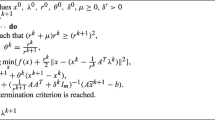Abstract
The subgradient method is used frequently to optimize dual functions in Lagrangian relaxation for separable integer programming problems. In the method, all subproblems must be solved optimally to obtain a subgradient direction. In this paper, the surrogate subgradient method is developed, where a proper direction can be obtained without solving optimally all the subproblems. In fact, only an approximate optimization of one subproblem is needed to get a proper surrogate subgradient direction, and the directions are smooth for problems of large size. The convergence of the algorithm is proved. Compared with methods that take effort to find better directions, this method can obtain good directions with much less effort and provides a new approach that is especially powerful for problems of very large size.
Similar content being viewed by others
References
Geoffrion, A. M., Lagrangian Relaxation for Integer Programming, Mathematical Programming Study, North Holland, Amsterdam, Holland, Vol. 2, pp. 82–114, 1974.
Hiriart-Urruty, J. B., and Lemarechal, C., Convex Analysis and Minimization Algorithms, Vols. 1–2, Springer Verlag, Berlin, Germany, 1993.
Wang, J., Luh, P. B., Zhao, X., and Wang, J., An Optimization-Based Algorithm for Job Shop Scheduling, Sadhana, Vol. 22, Part 2, pp. 241–256, 1997.
Kaskavelis, C. A., and Caramanis, M. C., Efficient Lagrangian Relaxation Algorithms for Real-Life-Size Job-Shop Scheduling Problems, Working Paper, Department of Manufacturing Engineering, Boston University, Boston, Massachusetts, 1995.
Liu, Y., and Storey, C., Efficient Generalized Conjugate Gradient Algorithms, Part 1: Theory, Journal of Optimization Theory and Applications, Vol. 69, pp. 129–137, 1991.
Nemhauser, G., and Wolsey, L., Integer and Combinatorial Optimization, John Wiley and Sons, New York, New York, 1988.
Bertsekas, D. P., Nonlinear Programming, Athena Scientific, Belmont, Massachusetts, pp. 594–595, 1995.
Sarin, S., Karwan, M. H., and Rardin, R. L., Surrogate Duality in a Branch-and-Bound Procedure for Integer Programming, European Journal of Operational Research, Vol. 33, pp. 326–333, 1988.
Camerini, P., Fratta, L., and Maffioli, F., On Improving Relaxation Methods by Modified Gradient Techniques, Mathematical Programming Study, North Holland, Amsterdam, Holland, Vol. 3, pp. 26–34, 1975.
Luh, P. B., and Hoitomi, D. J., Scheduling of Manufacturing Systems Using the Lagrangian Relaxation Technique, IEEE Transactions on Automatic Control, Vol. 38, pp. 1066–1079, 1993.
Author information
Authors and Affiliations
Rights and permissions
About this article
Cite this article
Zhao, X., Luh, P.B. & Wang, J. Surrogate Gradient Algorithm for Lagrangian Relaxation. Journal of Optimization Theory and Applications 100, 699–712 (1999). https://doi.org/10.1023/A:1022646725208
Issue Date:
DOI: https://doi.org/10.1023/A:1022646725208




